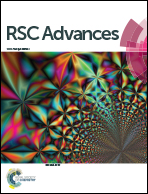Bicontinuous and cellular structure design of PVDF membranes by using binary solvents for the membrane distillation process†
Abstract
With excellent permeability as the foremost requirement for membranes used in the membrane distillation (MD) process, the thermally induced phase separation (TIPS) method is a promising approach for preparing porous membranes with a bicontinuous structure, which is identified as the best morphology for permeation. The structure design of membranes prepared by the TIPS process can be strengthened when a binary solvent is introduced in the casting solution. In this work, the determination principles for binary solvent were explicated in detail, and further employed for the selection of binary solvent for the fabrication of polyvinylidene fluoride (PVDF) membrane with different structures. By the TIPS approach, the porous PVDF hollow fiber membranes with cellular structure were generated by g-butyrolactone (GBL)/dioctyl phthalate (DOP) and GBL/dioctyl adipate (DOA) binary solvents, while the membrane with a bicontinuous structure was produced from GBL/dioctyl sebacate (DOS) binary solvent. The phase diagram was used to explain a feasible mechanism for the formation of the porous structures above. When the morphologies and properties of the membranes were characterized and compared, the membrane with a bicontinuous structure rather than a cellular structure was identified as the potential structure for MD processes with much higher tensile strength, narrower pore size distribution, higher MD flux and excellent long-term performance.



 Please wait while we load your content...
Please wait while we load your content...